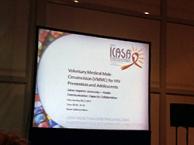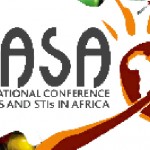Targeting VMMC Services to Adolescents Could Mean Greater Impact Overall
 Adolescent voluntary medical male circumcision (VMMC) is showing great promise in fighting HIV, according to the results of three country programs highlighted at an HC3-sponsored panel Sunday evening at the 17th International Conference on AIDS and STIs in Africa (ICASA).
Adolescent voluntary medical male circumcision (VMMC) is showing great promise in fighting HIV, according to the results of three country programs highlighted at an HC3-sponsored panel Sunday evening at the 17th International Conference on AIDS and STIs in Africa (ICASA).
Tanzania is now prioritizing adolescents in its VMMC program in part due to new modeling data that shows circumcising men ages 10-29 may have the greatest public health impact.
Dr. Augustino Hellar with MCHIP in Tanzania noted that current WHO guidelines are standardized and need to be adapted to reach different age groups. He called for making VMMC services more adolescent friendly by engaging adolescents in the program design and implementation, providing training for adolescents to serve as peer counselors and adapting the messaging in current tools and materials for younger men.
So far, Tanzania has performed 676,000 circumcisions and about 80% were adolescents aged 10 to 19, despite efforts to attract older men. Hellar noted a cultural preference for circumcision during childhood and adolescence, and shame associated with being circumcised as an adult, which help account for the young age of clients even in traditionally non-circumcising areas.
In Zimbabwe, PSI’s Pindu muSmart campaign is specifically targeted at 13 to 29 year-old men. Kumbirai Chatora, director of social marketing for PSI in Zimbabwe, noted that HIV incidence in Zimbabwe is highest among 20 to 29 year-old men, so targeting younger boys makes sense.
The social marketing campaign portrays circumcision as a lifestyle choice for cool trendsetting boys who like soccer and hip hop music. Pindu muSmart, which means “Be Smart, Be Clean,” is being promoted in school holiday campaigns in April, August and December with intensive mass media outreach.
Of the nearly 80,000 circumcisions performed between January and October 2013, 32,000 were from the Pindu muSmart school holiday campaign.
Pindu muSmart also makes use of social media, celebrities and community mobilization efforts to drive younger men to VMMC services. Chatora also noted the need to tailor messages pre- and post-VMMC to better suit adolescents.
The panel concluded with a presentation on the Brothers for Life campaign from Richard Delate of Johns Hopkins Health and Education South Africa (JHHESA). Brothers for Life launched in 2009 as the first social and behavior change communication (SBCC) program for VMMC in South Africa.
Delate noted that at the time the campaign launched, only 8% reported knowledge of the benefits of VMMC related to HIV. But in 2012, that number had grown to 48%. He also said there has been a huge increase in those accessing VMMC services with 1.4 million performed since 2010.
Brothers for Life conducted a national radio and television campaign, as well as other activities including community mobilization. Research now shows a direct impact with men exposed to the campaign 1.4 times more likely to intend to get circumcised.
Adolescent-friendly messaging and services for VMMC present an exciting opportunity for tackling the HIV epidemic in Africa. Including SBCC can help take maximum advantage of this opportunity.
Please find all three VMMC presentations below.
MCHIP: Seizing the Opportunity: Working with Adolescent Boys for an HIV-Free Generation
PSI: Pinda muSmart: Targeting Adolescents for VMMC in Zimbabwe
JHHESA: Impact of Brothers for Life on Intention for Medical Male Circumcision








Leave a Reply
Want to join the discussion?Feel free to contribute!